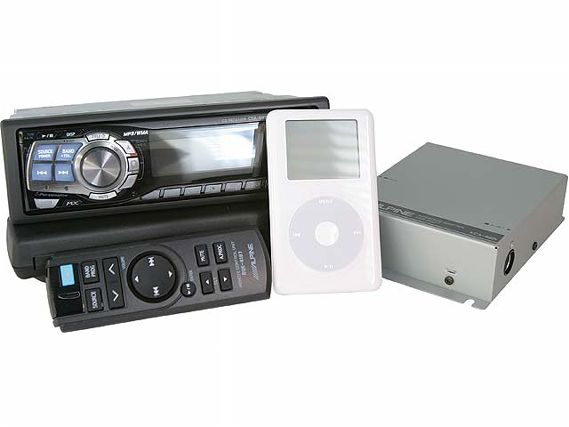 | In-Car iPod
| In-Car iPod
Behold this little metal box contraption from Alpine Electronics, which is possibly the best thing since sliced bread, the F22 motor, or Brooke Burke. This box-and-cable set, dubbed the KCA-420i, effectively marries Apple's iPod to your car audio system.
First, I confess to being something of a Mac dork. I grew up with Apple. I even wrote a program in BASIC for an elementary school project (a dumb little thing to track my dog's visits to the vet) on an Apple IIe. I've owned a handful of Macs since then, including an ill-fated Classic, Performa, and now a dual-processor G4. We even knock out every issue of HT on two iBooks, one eMac and art director Josh's G5 (with a whole gang of servers and IT voodoo in between).
So it's no surprise I'm an iPod fan. From the sales numbers, I'm not alone. Apple's piece of portable hard-drive love has taken off beyond the company's expectations. And since it's now also PC-compatible, the iPod appeals to computer users on both sides of the platform divide (for the record, I've also owned PCs. Got one for sale, actually).
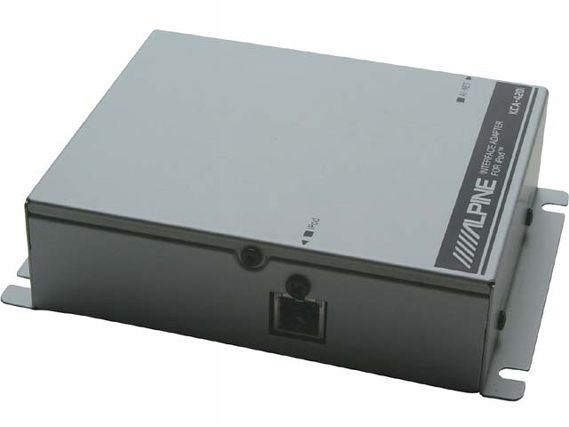 | In-Car iPod
| In-Car iPod
Interfacing the iPod with a car stereo system isn't new or even that difficult. A simple Y-cable with stereo RCA plugs on one end and a 1/8-inch mini-plug on the other does the trick. Simply plug the RCA ends into your receiver's auxiliary input (provided it has one), the mini-plug into the iPod's headphone jack, and cue up your favorite playlist.
There are only two problems with this scenario: first, you're running off of the iPod's internal battery, often regarded as the product's weakest point (six hours if you're lucky). Second, you still need to grab the iPod to select songs and playlists or adjust the volume. It's no big deal if you're waiting for a plane, but clumsy and dangerous if you're maneuvering through evening traffic and need to cue up some Metallica to get you through the commute.
The 420i ($100 suggested retail) eliminates both headaches. It not only provides juice to run the iPod, but also controls it like a CD changer. I took our test unit across town to Audio Designs, where Henry Sudit and Rene Gutierrez installed the 420i and an Alpine receiver in less than an hour. Gutierrez made a home for the 420i interface box, about the size of five CD cases stacked atop each other, behind the dash center console.
In our test setup, a 2-meter cable runs from the interface to a spot around the shifter and connects the iPod to the 420i. Another 2-meter cable connects the 420i to the receiver and carries data and control information. It's a simple, efficient setup.
In another magazine lifetime, I proclaimed that Kenwood's Music Keg, a PC-based hard-drive music system, would render the CD changer obsolete. And while the Keg hasn't done that single-handedly, the changer is still near the end of its usefulness. I believe that even more strongly with the advent of the iPod and other portable hard drive solutions.
One reason the changer has managed to hang on is because people still want CD-quality sound. For all the hype, MP3 is really a crap medium for music. The format was designed by engineers in the motion picture industry and compresses the hell out of audio data. The convenience of MP3's small file sizes found a home on Internet peer-to-peer filesharing sites and the rest is history (and possibly the end of the record business as we know it).
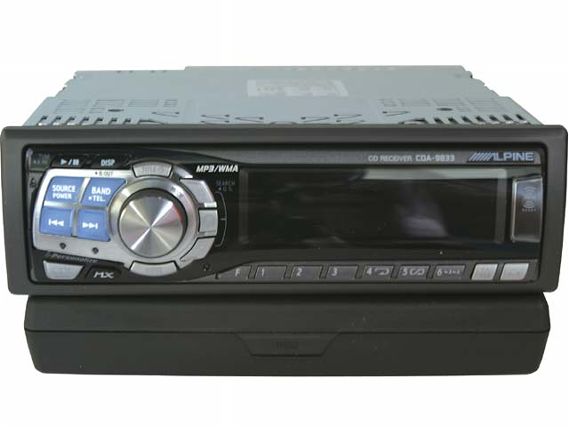 | In-Car iPod
| In-Car iPod
My chief complaint with MP3 revolves around its tendency to strip an audio file of any weight, particularly in the high and low frequencies. This might work fine on desktop computer speakers, but not a stock car audio system, let alone one into which you've sunk a little dough. Enter the genius of the iPod.
Used with iTunes software, the iPod can of course store MP3 files. But it can also store WAV and AIFF files, the same data that comes off of any standard compact disc. Each WAV/AIFF file weighs in approximately 10 times larger than its MP3 counterpart, but the payoff is CD-quality sound without compression or filtering. Even with the larger file sizes, I've stored about 30 albums worth of material on a 20-gigabyte model iPod.
Using the iPod with the 420i is simple and sweet. Plug in the Pod and it comes to life, drawing power from the interface. Select CD changer mode on the head unit and after a pause it brings up the iPod like it sees it, simply as a changer. Choose any display you like. You can search by playlist, artist, album or song. I prefer cueing up the iPod's entire library and setting it to shuffle. When you get to your destination, just unplug the iPod, lock it up in the glovebox or take it with you. When you plug it back in, it'll cue up to where it left over.
Brilliant, right? Absolutely, but not without a couple of catches. First off, you'll need an Alpine receiver that is Ai-Net capable. Ai-Net is simply Alpine's name for the data bus that controls CD changers and external processors. If you're using the stock head unit or another brand, you'll have to switch. But since you can get into an Ai-Net capable deck for under $200 (the CDA-9825), it's not a major obstacle.
Early adopters of the iPod also get the shaft, as the 420i doesn't play well with others. In fact, it only plays with the latest fourth-generation iPod and iPod Mini with the latest software update (as of April 28, 2004). Seems a little shortsighted on both Apple and Alpine's part. Then again, the computer industry isn't known for its reverence of history.
Still, consider that a new deck and CD changer will cost you about $400 and you're limited to six discs. For about $600 ($200 receiver, $100 interface, $300 20-gig iPod), you can step into the 420i system, carry four to five times the amount of music and get a portable hard drive in the bargain (the iPod can also store regular data--photos, text documents, etc--in addition to music files).
Now if this thing could just make peanut butter or even grease the wheels for a little Brooke/Angelina lingerie pillow fight, its value would surpass that of sliced bread.
iFollow
Some forthcoming options for iPod in the ca
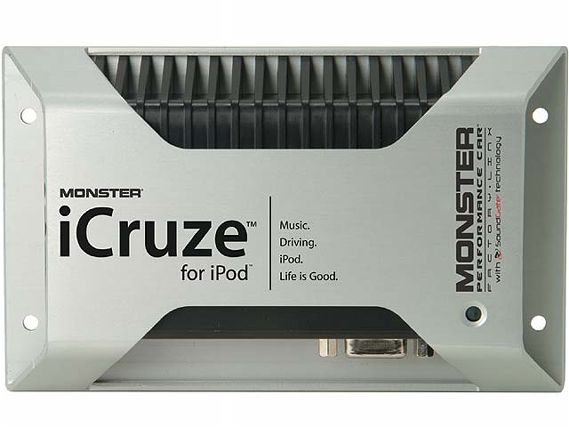 | In-Car iPod
| In-Car iPod
Monster iCruze
From the company formerly known as Monster Cable comes the iCruze, developed in conjunction with popular ICE interface maker SoundGate. Not unlike the 420i, iCruze uses the deck's existing CD changer or satellite radio port to pipe in the iPod's signal. The iCruze $200 suggested retail ranks 100 bills higher than Alpine's and it doesn't provide power. But it also doesn't limit you to only Alpine head units. Optional text display available if the deck doesn't reproduce text entry.
Monster iCarPlay Wireless Plus
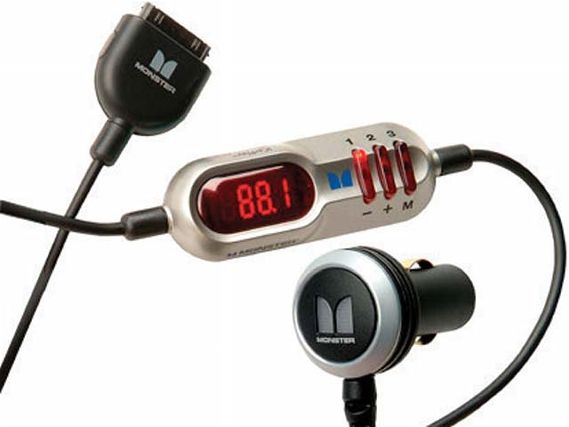 | In-Car iPod
| In-Car iPod
Here's one of the easiest ways to get iPod into your car. Simply connect the iPod and tune the wireless unit to a clear FM station in the 88-89Hz band, tune your radio to the same station, and hit Play. iCarPlay also provides juice via the cigarette lighter port. At $70, it's hard to beat. The only downside: like an FM modulator, sound quality depends on the strength of the FM signal.
Clarion VRX755VD
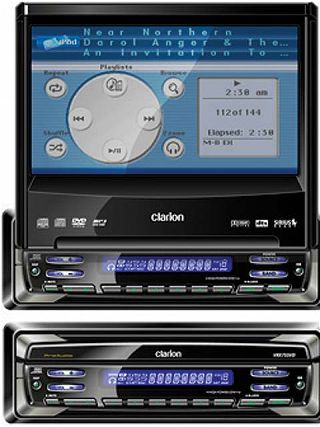 | In-Car iPod
| In-Car iPod
Clarion's new in-dash DVD/monitor combo threatens to steal some of Alpine's thunder. The seven-inch flip-out monitor displays the iPod's dial wheel for touchscreen control. The screen will also display the playlist, song and artist info. Clarion plans for an introduction at the January '05 CES show, with consumer launch to follow in February.
Alpine Electronics
800/ALPINE-1
www.alpine-usa.com
